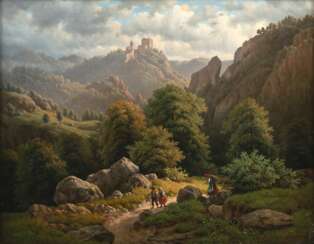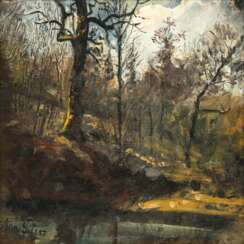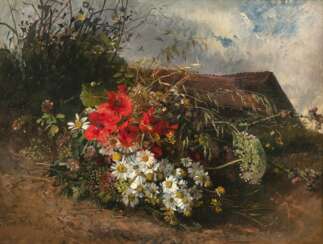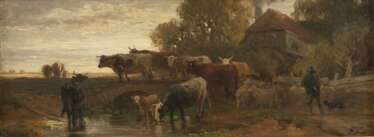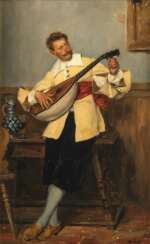
Paintings — 182_3: Alte Kunst & Antiquitäten, Tag II

Hermann Nestel was a German painter, graphic artist and illustrator. He studied art at the Academy of Fine Arts in Stuttgart and then in Munich, where he was influenced by the Munich School of painting, and in Berlin.
Nestel mainly painted landscapes, often depicting rural scenes in Germany and Italy. His paintings were known for their use of light and colour, which created a vivid and almost luminous quality to his work.
During his lifetime, Nestel's work was exhibited in various shows in Germany, Austria and Italy and he gained recognition as a talented artist. Today his work can be found in museums and private collections in Europe and the United States.
Despite his relatively short career, he left behind a significant body of work that is still admired by art lovers and collectors today.

Robert Eberle was a German painter. He was educated in Konstanz, where he was a pupil of the Swiss landscape and animal painter John Jacob Biedermann. In 1830 he moved to Munich and continued his education with Karl Theodor von Piloti and studied the works of Röysdal and Dujardin.
Eberle was known as a realist painter and quickly gained recognition for his genre scenes and depictions of animals, especially sheep, dogs and poultry. His son, Adolphe Eberle, was also an animal painter.

Jean-François Verheyden is a Belgian artist. He is known for his landscape and genre paintings as well as his portraits. Verheyden studied at the Royal Academy of Fine Arts in Brussels and later became a professor there. He exhibited his work in several salons in Brussels, Paris and London and was awarded medals for his paintings. François Verheyden was the father of the famous modernist painter Isidor Verheyden.

Heinrich Johann von Zügel was a German painter of the late nineteenth century and the first half of the twentieth century. He is known as a painter who specialized in depicting farm animals in dramatic and humorous situations.
Von Zügel invested more than 40 years in the subject of "Hard Labor," depicting mostly the work of oxen. By creating 24 versions of this subject, the artist demonstrated the evolution of his skill from realistic detailing to cubic and monumental interpretation. Von Zügel also created light impressionist paintings, including a self-portrait at the age of 77. In addition to animals, he also painted portraits and cityscapes.

Heinrich Johann von Zügel was a German painter of the late nineteenth century and the first half of the twentieth century. He is known as a painter who specialized in depicting farm animals in dramatic and humorous situations.
Von Zügel invested more than 40 years in the subject of "Hard Labor," depicting mostly the work of oxen. By creating 24 versions of this subject, the artist demonstrated the evolution of his skill from realistic detailing to cubic and monumental interpretation. Von Zügel also created light impressionist paintings, including a self-portrait at the age of 77. In addition to animals, he also painted portraits and cityscapes.

Heinrich Johann von Zügel was a German painter of the late nineteenth century and the first half of the twentieth century. He is known as a painter who specialized in depicting farm animals in dramatic and humorous situations.
Von Zügel invested more than 40 years in the subject of "Hard Labor," depicting mostly the work of oxen. By creating 24 versions of this subject, the artist demonstrated the evolution of his skill from realistic detailing to cubic and monumental interpretation. Von Zügel also created light impressionist paintings, including a self-portrait at the age of 77. In addition to animals, he also painted portraits and cityscapes.
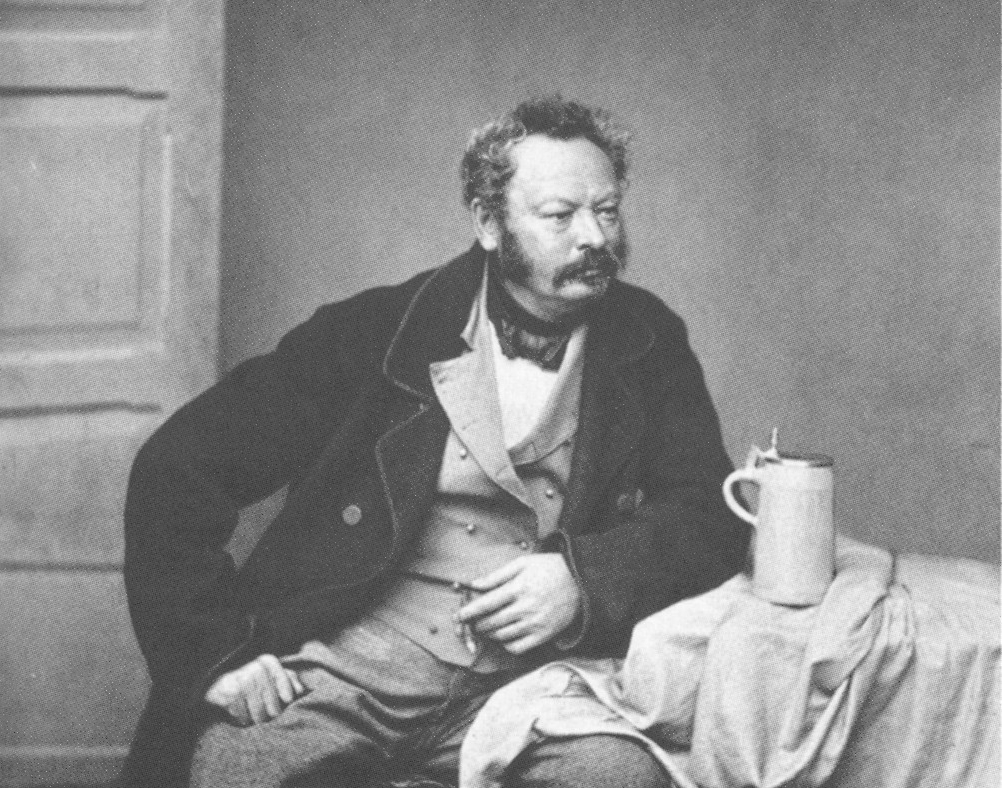
Heinrich Bürkel was a German artist of the mid-nineteenth century. He is known as a painter and graphic artist, representative of the Biedermeier style.
Heinrich Bürkel specialized in genre and landscape paintings, especially winter landscapes. He often used Staffage and depicted animals. His work showed the influence of the old Dutch and Italian masters. Bürkel enjoyed great popularity, his paintings were actively acquired for private collections, including in America. The master painted about 1000 paintings and created about 6000 drawings.

Carl Wilhelm Müller was actually a German landscape painter born in Dresden. He studied at the Academy of Fine Arts in Dresden before moving to Munich, where he continued his studies under the painter Eduard Schleich the Elder.
Müller's early works were heavily influenced by the Romantic tradition of landscape painting, and he often painted idyllic scenes of forests, rivers, and mountains. Later in his career, he developed a more impressionistic style that emphasized the effects of light and color.
Müller was a prolific painter and exhibited his works widely throughout Germany and Europe. He was a member of the Munich Secession and the Dresden Art Society, and he received numerous awards and honors during his lifetime. Today, his works can be found in many public and private collections throughout Germany and beyond.

Julius Lange is a German painter. Most of his paintings are landscapes, mainly of the mountains.
He studied painting at the Munich and later at the Dusseldorf Academy of Arts with Johann Wilhelm Schirmer.
Worked for a long time in Northern Italy, including Venice and Milan, receiving commissions from local academies and nobles. From 1868 he held the position of court painter in Munich and painted many works for King Maximilian II and his son King Ludwig II, as well as interior designs for the royal castles Herrenchiemsee and Linderhof.

Anna Peters (German: Anna Peters) was a German artist. She was best known for her floral still lifes and landscape paintings, which were highly regarded during her lifetime.
Peters' style was strongly influenced by the Romantic movement, which emphasised the emotional and spiritual aspects of nature. She was particularly adept at conveying the atmospheric effects of light and weather in her paintings. Her landscapes often feature dramatic cloud formations, misty valleys and luminous skies.
In the late 1890s Anna Peters developed a more impressionistic style of painting.
Peters' work was widely exhibited during her lifetime, both in Germany and abroad. She was a member of several renowned art associations, including the Berlin and Munich Secession. Her paintings can be found in many public and private collections, including the National Gallery in Berlin and the Bildenkünste Museum in Leipzig. Today, Anna Peters is regarded as one of the leading landscape painters of her generation in Germany.

Anna Peters (German: Anna Peters) was a German artist. She was best known for her floral still lifes and landscape paintings, which were highly regarded during her lifetime.
Peters' style was strongly influenced by the Romantic movement, which emphasised the emotional and spiritual aspects of nature. She was particularly adept at conveying the atmospheric effects of light and weather in her paintings. Her landscapes often feature dramatic cloud formations, misty valleys and luminous skies.
In the late 1890s Anna Peters developed a more impressionistic style of painting.
Peters' work was widely exhibited during her lifetime, both in Germany and abroad. She was a member of several renowned art associations, including the Berlin and Munich Secession. Her paintings can be found in many public and private collections, including the National Gallery in Berlin and the Bildenkünste Museum in Leipzig. Today, Anna Peters is regarded as one of the leading landscape painters of her generation in Germany.

Anna Peters (German: Anna Peters) was a German artist. She was best known for her floral still lifes and landscape paintings, which were highly regarded during her lifetime.
Peters' style was strongly influenced by the Romantic movement, which emphasised the emotional and spiritual aspects of nature. She was particularly adept at conveying the atmospheric effects of light and weather in her paintings. Her landscapes often feature dramatic cloud formations, misty valleys and luminous skies.
In the late 1890s Anna Peters developed a more impressionistic style of painting.
Peters' work was widely exhibited during her lifetime, both in Germany and abroad. She was a member of several renowned art associations, including the Berlin and Munich Secession. Her paintings can be found in many public and private collections, including the National Gallery in Berlin and the Bildenkünste Museum in Leipzig. Today, Anna Peters is regarded as one of the leading landscape painters of her generation in Germany.

Anna Peters (German: Anna Peters) was a German artist. She was best known for her floral still lifes and landscape paintings, which were highly regarded during her lifetime.
Peters' style was strongly influenced by the Romantic movement, which emphasised the emotional and spiritual aspects of nature. She was particularly adept at conveying the atmospheric effects of light and weather in her paintings. Her landscapes often feature dramatic cloud formations, misty valleys and luminous skies.
In the late 1890s Anna Peters developed a more impressionistic style of painting.
Peters' work was widely exhibited during her lifetime, both in Germany and abroad. She was a member of several renowned art associations, including the Berlin and Munich Secession. Her paintings can be found in many public and private collections, including the National Gallery in Berlin and the Bildenkünste Museum in Leipzig. Today, Anna Peters is regarded as one of the leading landscape painters of her generation in Germany.

Alexander Max Koester was a German painter. He depicted coastal landscapes and still lifes with flowers. After the artist first presented one of his landscapes with a family of ducks in Berlin in 1899, he earned the nickname "Duck Koester." The "duck" paintings were extremely popular with art lovers.

Henry Garland was a British painter. He was primarily known for his landscape paintings, which often depicted rural scenes of England, Scotland and Wales.
Garland's work is characterised by a romanticised view of the countryside with rolling hills, livestock and tranquil streams. The painter was particularly adept at capturing the atmospheric effects of light and weather in his paintings, and his use of colour was subtle and evocative.
Today Henry Garland is regarded as one of the leading British landscape painters of his generation, and his work is still highly regarded for its sensitivity to the natural world and its depiction of a rapidly changing society.
.jpg)
Eugen Felix, born as Veith Ehrenstamm was an Austrian painter.
He started his studies with Ferdinand Georg Waldmüller and continued in Paris with Léon Cogniet. Felix is particularly well known for his portraits, but he also did historic and mythological scenes.

Max Todt was a German genre painter.
Max Todt studied painting at the Düsseldorf Academy of Arts from 1863 to 1867. His teachers there were Andreas and Karl Müller, Heinrich Mücke and Julius Roeting. He was also a private pupil of Wilhelm Sohn. From 1870 to 1871 he took part in the Franco-Prussian War as a volunteer and returned home in bad health. Afterwards he remained incapacitated for a long time. In 1877 he moved to Munich. He occupied himself with genre painting, preferring scenes from the time of the Thirty Years' War.

Etienne Prosper Berne-Bellecour was a French artist. He was a painter, illustrator, and engraver who specialized in military scenes, battlefields, and portraits of soldiers. He is considered one of the most important French artists of the 19th century.
Berne-Bellecour began his career as an illustrator for French newspapers and magazines. He later became a painter, and in 1863 he exhibited his first painting at the Salon in Paris. In 1873, he became a member of the Académie des Beaux-Arts.
Berne-Bellecour was known for his highly detailed and realistic paintings of military life. He often depicted battle scenes with soldiers in uniform, and his attention to detail was highly admired. He was also known for his portraits of military leaders, including Napoleon III and Marshal MacMahon.
Berne-Bellecour continued to paint and exhibit his work throughout his life.

Otto Reiniger was a German artist. He was a painter and illustrator who is best known for his landscape paintings, which often depicted the natural beauty of the German countryside.
Reiniger studied art in Stuttgart, Munich, and Paris. He was heavily influenced by the Impressionist movement and often used vibrant colors and loose brushstrokes in his paintings. He exhibited his work at several exhibitions throughout Germany, including the Munich Secession in 1893 and the Great Berlin Art Exhibition in 1898.
Reiniger's paintings were highly regarded for their vivid depictions of nature and their ability to capture the essence of the German landscape. He was particularly drawn to the forests and mountains of southern Germany, and many of his paintings feature these natural landscapes.
Despite his relatively short career, Reiniger's work had a significant impact on the German art world. Today, his paintings are highly sought after by collectors and can be found in several museums and private collections around the world.


